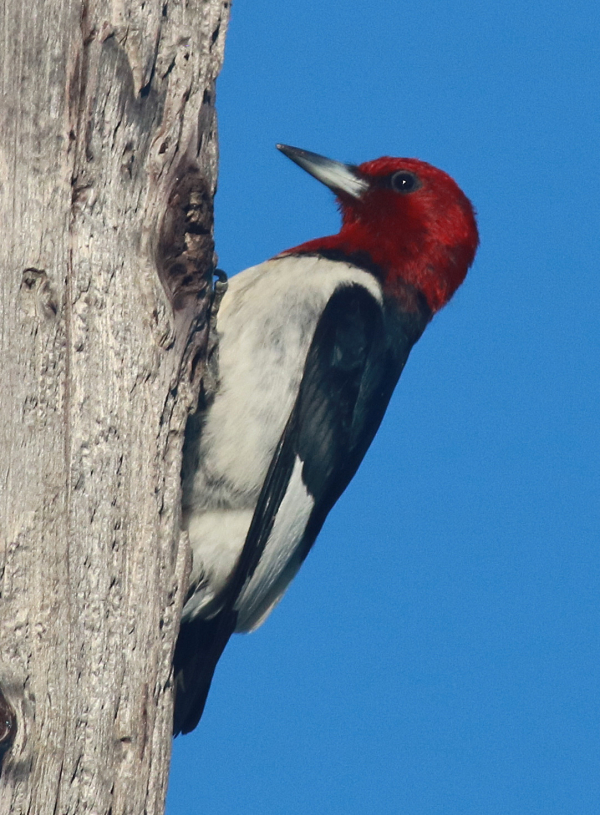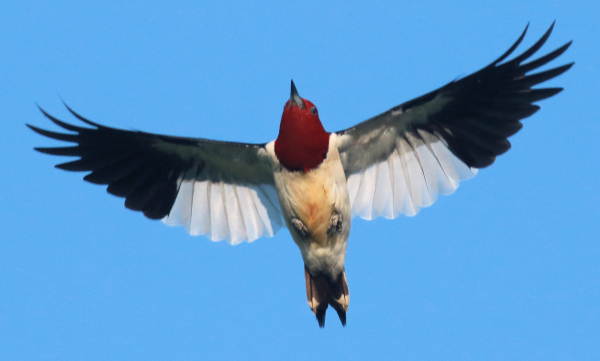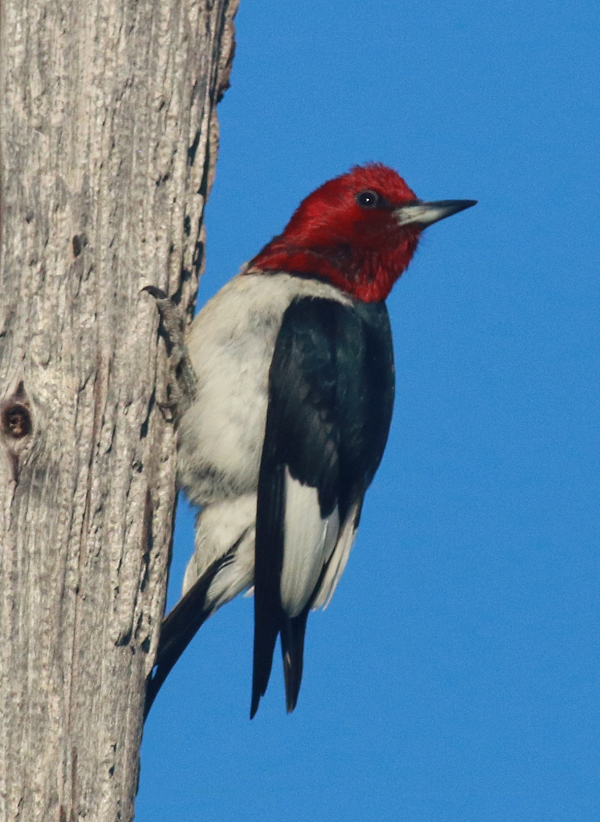
After years without a good photo to show, Paul finally made a breakthrough Saturday evening, when a pair of Red-headed Woodpeckers provided several photo opportunities.

Concentrating on flight photos for part of the photo session, Paul was able to get this memorable photograph of a Red-head as it flared its wings to land on a nearby hunting perch.

There’s something very special about Red-headed Woodpeckers that makes them so attractive to birders.
|
EDITOR AFIELD
Join the Editor for Weekly Birding Highlights
I was thrilled to find a second pair of Red-headed Woodpeckers, who revealed the location of their nesting cavity to me; but even more exciting was the fact that they permitted me to park near one of their hunting perches – a tall weathered gray snag. I have always been attracted to Red-headed Woodpeckers, but they are not common anywhere in their range that I have found, so to be so close with the light of the setting sun to work with, I enjoyed taking the first of what I hope will be a productive series of photos. I feel like I’m already getting to know the pair and their hunting perches as they have kind of accepted my vehicle (mobile blind) and the unusual sound of my camera.
The 4th of July, and the 5th, were overcast with periodic showers, keeping the area green and greener, but Saturday proved to be a perfect day weather-wise with perfect evening light that provided a second opportunity to spend time with the woodpeckers. It was an evening that left me with a euphoric feeling in the company of these impressive birds, along with a Northern Flicker, Western Meadowlarks, a pair of Orchard Orioles, a male Red-winged Blackbird, and a Ring-necked Pheasant. I managed some much appreciated photo ops with the striking woodpeckers as they hawked insects from a number of perches, including the one closest to me. In addition to characteristic photos of the woodpeckers perched vertically, I worked on action photos of the birds in flight, which provided a varied success rate between zero and 100 percent.
To call these woodpeckers “red-headed” is very simplistic, for when you see them alive and illuminated, their color is more a rich velvety burgundy red, accented by the striking black and white colors of the rest of their plumage. Then too, when illuminated, the black feathers show a beautiful blue iridescence that can only be recorded with the human eye and today’s advanced digital photography equipment. How exciting to share this time among these interesting woodpeckers after so many years of hoping for such an opportunity. I look forward to many more photo sessions with the rich velvety burgundy Red-head Woodpeckers – and maybe someday soon a fledgling or two, who will sport gray heads rather than rich velvety burgundy red heads.
Last Wednesday I also checked on the Bald Eagle nestlings to check their status the night before Independence Day. One looked like it was ready to fledge, but Sunday evening there were still three big, fully feathered young eagles in the nest. One was particularly active, flapping its wings above its back while facing into the southeast wind. Its flight feathers looked fully formed, so it could fledge any day now. I’ve never had the fortune to study the post-fledging behavior of Bald Eagles before, so I’m excited to see how these birds behave firsthand; and I’ll share my sightings with you.
Wednesday I found a surprising number of duck broods at a shallow marsh I drive by a couple times most days. The collection of broods included 2 month-old broods of Northern Pintails, each with an attending hen and 8 and 10 ducklings. A newly hatched brood of Gadwalls that had both a female and a male with them provided a nice family scene, as did a pair of Northern Shovelers with a week-old brood of 7 large-billed ducklings. I was also interested to see a pair of American Avocets with 2 week-old hatchlings searching for food along the edge of an island in the same wetland.
Saturday evening provided two more interesting duck broods, an unusual brood of just 1 newly hatched Gadwall duckling with the hen, plus an early Lesser Scaup brood of 5 feeding around the female, each a small brown downy fluffball. Although I haven’t done any brood surveys yet, I found five more new broods Sunday eve, including a Northern Shoveler brood of 9, a Gadwall brood of 11, two Mallard broods numbering 8 and 6, and a brood of 8 little Blue-winged Teal ducklings.
Backyard Fun
Twice on Friday afternoon, a Gray Catbird perched at my feeding station – the first catbird I’ve seen in the area since May migration. Although the catbird seemed inquisitive, it didn’t find anything too attractive I guess. Saturday, the newest feeder visitor was an immature Baltimore Oriole, the first since spring migration. Apparently it was a harbinger, considering that Sunday afternoon I sighted at least four immature or female Baltimore Orioles feeding one by one on grape jelly, along with two males – signs of a post-nesting movement no doubt. The more the merrier!
While landscaping in my backyard, a robin was making a loud contact call nearby. As the calls became progressively closer I thought perhaps it was after some of the many earthworms I had unearthed. Suddenly, it seemed like the bird called directly into my ear. I another closer look around, and there, just three feet away, was a small fledgling robin checking me out. I had been pretty stationary as I prepared a transplant bed on my hands and knees, so it obviously was interested in my appearance in its realm, even approaching progressively closer.
It circled around a while longer, making an occasional contact call so I could follow its progress under the cover of my lilacs – kind of a sweet encounter I thought I’d share. Hope your holiday week had a few birding surprises, at home and in the field.
Article and photos by Paul Konrad
Share your bird sightings and photos at editorstbw2@gmail.com